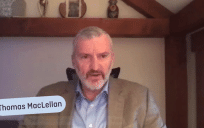Fog computing can transform agencies as it enables cloud on devices at the edge of their IT networks such as smartphones. Even better, fog computing is compatible with hybrid clouds, or the mix of publicly available cloud services with private environments such as on-premise IT that many agencies use.
Challenge: Sprawling IT
Mississippi Chief Information Officer (CIO) Craig Orgeron says that before the state adopted cloud computing, agencies were slowly disappearing under a mountain of IT. “We had significant infrastructure sprawl,” Orgeron said. “We had lots of IT in many places.”
He adds that physical IT was causing Mississippi’s infrastructure sprawl. The resulting clutter made adopting new IT services harder for state agencies. “Data centers, server farms or older, mainframe technologies were the bread and butter of centralized IT for decades,” he said. “And our governance model made it more difficult to put solutions in place.”
Ultimately, the Department of Information Technology Services (ITS) embraced hybrid cloud to start clearing away Mississippi’s overgrown IT. Orgeron notes that since embracing hybrid cloud, Mississippi has started delivering IT services statewide from one data center. “We’re federated as a state,” said Orgeron, who is also ITS’ Executive Director. “We’re not monolithic with all our IT people working under one roof. We’re much more of a classic shared service organization.”
Gradually, agencies such as ITS that reduce their physical IT save energy, funding and space that was previously spent maintaining it.
Solution: Extending IT’s Reach With Hybrid Cloud
Hybrid cloud now allows scores of agencies across Mississippi to use IT services without building costly, dense physical infrastructure first. “With relatively nominal capital investments, we can set up an ecosystem that we believe goes a lot farther distance for IT that can be consumed,” Orgeron said. “It’s not just the statewide agencies, but the local governments, too. That’s where the magic of consumable IT and compute services is a real sweet spot.”
As Orgeron sees it, hybrid cloud has made ITS the broker for many of Mississippi’s state and local agencies. By using cloud’s scalability, ITS has managed to deliver convenient, reliable IT services such as computing power to agencies as they need them. “The scale is so great in cloud,” he said. “You can’t compete against it. Hybrid cloud made us able to offer a much more robust capacity. Convenience and reliability is a big one-two punch.”
Even better, hybrid cloud now offers many of Mississippi’s agencies a safety net for business continuity and natural disaster recovery. “You can do these things on a rolling, more flexible model,” he said.
Outcome: A Fog Computing Future
Where can agencies such as ITS head after deploying hybrid cloud? One possibility is fog computing, which extends cloud services past the edge of an agency’s IT networks. Once past that point, fog computing enables cloud on edge devices such as smartphones and tablets. “There’s some dipping our toe in the water,” Orgeron said of Mississippi. “Fog computing is a blend of classic and edged-based cloud.”
Although Mississippi doesn’t have enterprise fog computing yet, Orgeron said it has major potential for the state. For example, it could help agencies deliver IT services from a central location to various Internet of Things (IoT) devices, which are tools that can connect via the internet and share data with one another. “You’re gathering data of some kind or another at the edge,” he said of IoT networks.
Orgeron estimates that Mississippi is several years away from broad fog computing, but hybrid cloud’s farreaching, on-demand services could eventually make it possible. “Consumable, commoditized technology is where it’s at,” he said.
This blog is an excerpt from our recent guide, “Technology Transformation Strategies: From Idea to Implementation.” Download the full guide here for best practices.





Leave a Reply
You must be logged in to post a comment.